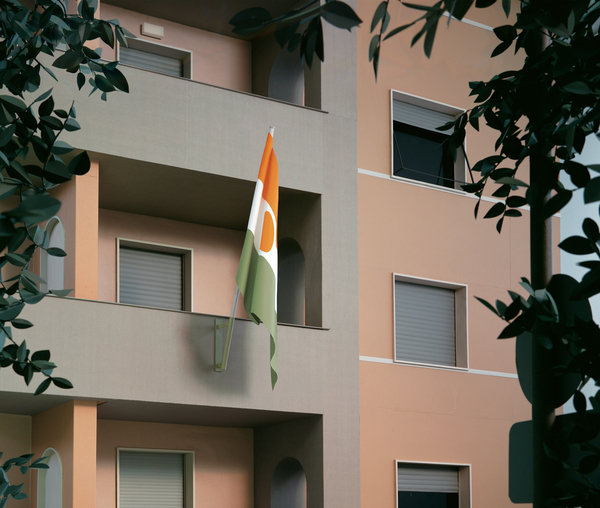Thomas Demand
dal 24/9/2009 al 28/11/2009
Segnalato da
24/9/2009
Thomas Demand
Museum Moderner Kunst MUMOK, Wien
Demand's pictures often show deserted architectural constructs of explosive social or political events that are anchored in our collective consciousness. Although the photographs seem at first to be of real, existing places, they prove at second glance to be clever reconstructions of reality. Starting out with well-known photographic sources from the mass media, the artist constructs true-to-detail models made of paper and cardboard, which he photographs with a large-format camera, only to destroy them again.

curated by Edelbert Köb
In the Factory the MUMOK is presenting Presidency (2008) and
Embassy (2007), the two well-known work series by Thomas Demand,
born in 1964 in Munich. Demand, who is described as a documentary
witness of our worlds of media and creates his impact beyond
photography as an illusionist, is one of the most sought-after artists
on the contemporary scene. His large-format photographic works
have already been acclaimed in the Museum of Modern Art in New
York and during the Biennale in Venice. At present the Neue
Nationalgalerie Berlin is presenting a major retrospective of his works
titled “Nationalgalerie”.
Thomas Demand’s pictures often show deserted architectural constructs
of explosive social or political events that are anchored in our collective
consciousness. Although the photographs seem at first to be of real,
existing places, they prove at second glance to be clever reconstructions
of reality. Starting out with well-known photographic sources from the
mass media, the artist constructs true-to-detail models made of paper
and cardboard, which he photographs with a large-format camera, only
to destroy them again. Thus these life-size reconstructions by Thomas
Demand eschew all people, all signs of wear and tear, and all traces and
clues of the “scene-of-the-crime” or theatre of action that might have
been newsworthy and were visible on the original photos. This gives
these “phantom pictures” the effect of having just just been abandoned
or newly created.
Among the pictures he alludes to are the security gate which Mohammed
Atta passed through on the fateful day of 11 September 2001 to get into
the airport waiting room (Gate, 2004 — MUMOK Collection) and the
photos, still lingering in our memory, of the tunnel in which Princess
Diana accidentally met her death (Tunnel, 1999).
Demand’s work is a critical and paradoxical commentary on the equivocal
promise of authenticity in media images, their self-evidence and their
diffuse proliferation in the collective memory. His works — based on a
sculptural concept — are dependent on a work process that is carried to
extremes in its personal and time-consuming intensity. Numerous
associates are employed in producing the three-dimensional paper
scenery for the major projects.
Presidency (2008)
Thomas Demand turns his attention in the five-part work Presidency to
one of the most prominent theatres of power — the US President’s office
in the White House. He built a meticulously detailed model of the Oval
Office in the original size out of paper, cardboard and confetti, which he
photographed and then destroyed. The series was initially commissioned
for a cover story of the “New York Times Magazine” of 9 November 2008,
five days after the presidential election in the United States.
Presidency shows the medium suddenly playing a new role: while Thomas
Demand usually takes his images and motifs from magazines, this time
the magazine itself commissioned the replica, considering it more
pertinent to the abstract and fundamental content of the accompanying
text.
Embassy (2007)
The Embassy series shows Thomas Demand investigating a scandalous
incident that took place in January 2001 in the Niger Embassy in Rome:
after a break-in, blank stationery and stamps disappeared that were used
later to fabricate proofs of a supposed operation to smuggle uranium into
Iraq. The faked documents were eventually used by the Bush
administration as a legitimation for the war in Iraq.
To produce the nine-part work-group of Embassy — it shows the exterior
façade as well as the staircase and the embassy interior — the artist had to
depart from his usual work method. Since there weren’t any photos
published of the incident, Demand himself took on the role of reporter.
He managed to gain access to the sealed-off rooms and afterwards
replicated the ambassador’s office in his studio from memory. The artist
sees his work as “semi-journalism”: “I’m not concerned with truth, with
facts, facts, facts, but with a story to which the picture’s missing.”
Both works are linked to each other not only through their motif as places
of state representation. The extreme popularity of the Oval Office is in
diametrical contrast to the clandestine site of the Niger Embassy, yet
both places are historical “theatres” of action in Demand’s ideation.
Press contact
Eva Engelberger
Telephone +43-1-52500-1400
eva.engelberger@mumok.at
Barbara Hammerschmied
Telephone +43-1-52500-1450
barbara.hammerschmied@mumok.at
Opening 25 September 2009, 7 pm
MUMOK (MUMOK Factory)
Museumsplatz 1, A — 1070 Vienna
Opening times Monday -Sunday 10 am — 6 pm
Thursday 10 am — 9 pm
Admission normal EUR 9.-
reduced EUR 7.20 and EUR 6.50



